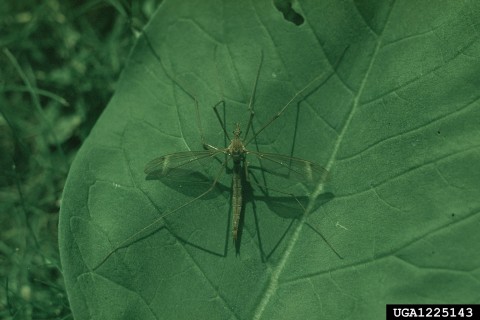
Adult crane fly. Photo: Edward L. Manigault, Clemson University Donated Collection, Bugwood.org
Have you seen these long-legged insects flying around your lawn or home recently? No, they are not large mosquitoes. They are adult European crane flies.
Contrary to what chemical companies may tell you, right now is not the time to worry about or treat for this insect.
You cannot control crane flies by using insecticides when the adults are flying. They don’t stay still long enough. They emerge, fly and lay eggs in a short time. They may drive you crazy, but they are harmless.
Crane fly populations often decline over the winter due to cold and disease. Many birds, including starlings and robins, love to eat the grubs.
The best time to check for crane flies is early spring. We will monitor your lawn for crane flies in February and March.
Not all crane flies are pests. There are 12-14 native crane flies that are beneficial in streams and forests. Only the European crane fly, an imported species, causes any problems. And even that one is seldom a problem. A survey of almost 200 lawns in Whatcom County found that none had enough crane flies to require any pest controls.
The best crane fly control is to improve lawn health through proper fertilization, mowing, watering and other care. A healthy lawn will easily recover from crane fly damage, even when the population is high.
What you can do
- Ask us about fall aeration and fertilization.
- Water your lawn deeply and infrequently. The crane fly likes very soggy soil, so drying out the soil will help reduce its numbers.

Crane flies may not be common, but I had a horrible infestation due to our poorly draining soil in the area, which killed off 40% of my lawn and required extensive reseeding. When the technician pulled up the sod their were several dozen of the grubs in the soggiest areas of my lawn. Stay on top of these guys, especially if you have a poorly draining lawn.